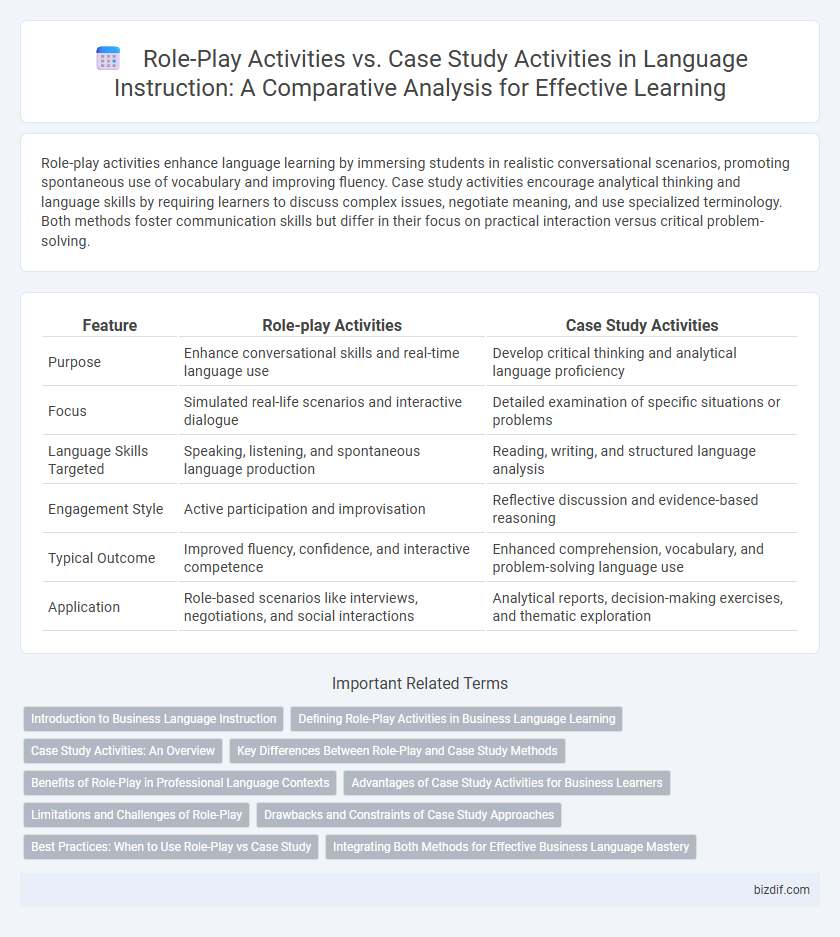Role-play activities enhance language learning by immersing students in realistic conversational scenarios, promoting spontaneous use of vocabulary and improving fluency. Case study activities encourage analytical thinking and language skills by requiring learners to discuss complex issues, negotiate meaning, and use specialized terminology. Both methods foster communication skills but differ in their focus on practical interaction versus critical problem-solving.
Table of Comparison
| Feature | Role-play Activities | Case Study Activities |
|---|---|---|
| Purpose | Enhance conversational skills and real-time language use | Develop critical thinking and analytical language proficiency |
| Focus | Simulated real-life scenarios and interactive dialogue | Detailed examination of specific situations or problems |
| Language Skills Targeted | Speaking, listening, and spontaneous language production | Reading, writing, and structured language analysis |
| Engagement Style | Active participation and improvisation | Reflective discussion and evidence-based reasoning |
| Typical Outcome | Improved fluency, confidence, and interactive competence | Enhanced comprehension, vocabulary, and problem-solving language use |
| Application | Role-based scenarios like interviews, negotiations, and social interactions | Analytical reports, decision-making exercises, and thematic exploration |
Introduction to Business Language Instruction
Role-play activities in business language instruction simulate real-world interactions, enhancing practical communication skills and cultural fluency in professional settings. Case study activities focus on analyzing complex business scenarios, promoting critical thinking and specialized vocabulary related to industry challenges. Both approaches complement each other by combining experiential learning with theoretical problem-solving to build comprehensive language proficiency.
Defining Role-Play Activities in Business Language Learning
Role-play activities in business language learning simulate real-world interactions, enabling learners to practice communication skills in authentic professional contexts such as meetings, negotiations, or presentations. These exercises emphasize spontaneous language use, decision-making, and interpersonal dynamics, fostering practical fluency and confidence. Unlike case study activities, which analyze situations from a strategic perspective, role-plays actively engage learners in performing specific roles to develop pragmatic language competencies.
Case Study Activities: An Overview
Case study activities offer an immersive approach to language instruction by presenting learners with real-world scenarios that require critical thinking and problem-solving skills. These activities enhance vocabulary acquisition and pragmatic language use through contextual analysis and discussion, fostering deeper comprehension. Incorporating case studies in language curricula promotes interactive learning, cultural awareness, and the ability to apply linguistic knowledge in authentic contexts.
Key Differences Between Role-Play and Case Study Methods
Role-play activities engage learners in simulated real-life scenarios, promoting active participation, interpersonal communication skills, and immediate feedback, whereas case study activities involve in-depth analysis of real or hypothetical situations, emphasizing critical thinking, problem-solving, and application of theoretical knowledge. Role-play enhances empathy and decision-making under pressure, while case studies foster analytical skills and strategic planning through detailed examination of complex issues. Both methods serve distinct educational purposes, catering to diverse learning objectives within language instruction.
Benefits of Role-Play in Professional Language Contexts
Role-play activities enhance communicative competence by simulating real-life professional scenarios, fostering spontaneous language use, and improving interpersonal skills. Engaging in role-play allows learners to practice industry-specific vocabulary and adapt to diverse cultural contexts, increasing confidence in workplace interactions. These interactive exercises promote critical thinking and immediate feedback, accelerating language acquisition more effectively than passive case study activities.
Advantages of Case Study Activities for Business Learners
Case study activities offer business learners practical insights by analyzing real-world scenarios, fostering critical thinking and decision-making skills essential for strategic leadership. These activities enable learners to dissect complex business problems, enhancing their ability to apply theoretical knowledge to diverse organizational contexts. Case studies also promote collaborative learning and communication by encouraging discussion of business strategies and outcomes among peers.
Limitations and Challenges of Role-Play
Role-play activities often face challenges such as limited realism, which can hinder students' ability to fully immerse and transfer skills to real-life situations. Participants may feel self-conscious or anxious, reducing engagement and authenticity during role-play exercises. Additionally, role-plays require significant preparation and skilled facilitation to ensure constructive feedback and learning outcomes, presenting logistical and resource constraints in language instruction settings.
Drawbacks and Constraints of Case Study Approaches
Case study activities in language instruction often face limitations such as reduced learner engagement due to passive observation and lack of real-time interaction. These approaches can constrain the development of spontaneous conversational skills and may not effectively simulate authentic communication scenarios. The complexity and time required for case study analysis can also limit the breadth of language practice opportunities within a curriculum.
Best Practices: When to Use Role-Play vs Case Study
Role-play activities are best utilized for developing interpersonal communication skills, practicing real-life scenarios, and enhancing empathy by engaging participants in dynamic, interactive situations. Case study activities excel in promoting critical thinking, problem-solving, and analytical skills through detailed examination of complex, real-world problems and decision-making processes. Use role-play when fostering experiential learning and emotional engagement, while case studies are ideal for in-depth analysis and application of theoretical concepts.
Integrating Both Methods for Effective Business Language Mastery
Integrating role-play activities and case study exercises enhances business language mastery by combining practical communication skills with critical analytical thinking. Role-play activities simulate real-world business interactions, promoting fluent language use and cultural nuances, while case studies develop problem-solving abilities and domain-specific vocabulary through contextual analysis. Leveraging both methods creates a dynamic learning environment that fosters comprehensive language competency and professional effectiveness in international business settings.
Role-play Activities vs Case Study Activities Infographic

 bizdif.com
bizdif.com